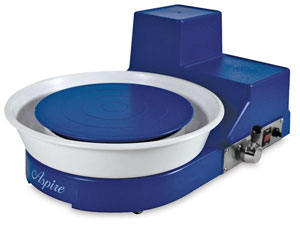Buying a pottery wheel can be quite an expensive issue.
Whilst second hand wheels exist it is difficult to judge their state of repair and future reliability. Therefore make sure you make an informed choice.
So what factors should you consider when buying your pottery wheel?
Weight of clay
When choosing a pottery wheel the weight of clay you intend to throw decides the power of the motor you will need for a power driven wheel.
Typical weights are as follows:
- ¼ HP for small pottery items 20lbs (10kgs approx) max for beginners
- ½ HP for medium sized items up to 100lbs (25 kgs approx) max suitable for most commercial potters
- 1 HP for large items 200lbs (50kgs approx) for experienced potters making very large items.
Quality and ease of operation
Quality of wheel can be an issue as it comes at a price. However you should also consider at least:
- Noise-older type wheels can be quite noisy whilst some recent models are whisper quiet
- Smoothness of pedal operation
- Smoothness of wheel particularly at low speeds- a jerky transition of speed can cause difficulties -important for delicate shaping
- Reversability-can it be used by left and right handed people?
- Electric or kick-wheel operation? Foot pedal or hand lever operation?
Whilst kick wheel models may be cheaper they can take some getting use to if you are already used to an electric powered
- Wheel head size and predrilled holes- The wheel head size dictates the max diameter of clay piece which can be thrown. Holes in the wheelhead allow a bat (special disc) to be used. Pins allow release of the bat, holding the thrown piece, from the wheelhead. The thrown piece can then be removed easily for drying while a new piece is thrown.
Mobility
Some wheels are very light in weight and designed to be portable whilst others are meant to be static. Consider if you want to move the wheel between different locations. Heavy powerful wheels can be more durable and long lasting.
Examples of different wheel types are:
A Tabletop Wheel
  
The Shimpo Aspire can handle your most creative challenges. Its lightweight, compact design makes it easy to transport, and a 20 lb centering capacity makes it a practical addition to any studio or classroom. The Aspire features a 1/3 HP, 100W DC motor, a 7" alloy wheel head, and a removable one-piece splash pan. The wheels speed ranges from 0–230 rpm, controlled by a hand lever. Also included are two 9¾" bats. It measures 9" H × 14½" W × 20" L and weighs 25 lb . Amazing, affordable, accommodating … Aspire! Shimpo’s Aspire Pottery Wheel includes a two-year limited manufacturer’s warranty.
A Powerful model suitable for seated use
Brent wheel Model B is designed to fill the needs of schools and studio potters. Competitively priced, this wheel is quiet and solid under 150 lb (68 kg) loads of clay. A 1/2 HP motor provides the power and weight necessary for school use. A splash pan and 12" Plasti-Bat are included. Shipping weight is 112 lb (51 kg). Truck shipment is required. 10-year limited warranty. CE-certified.
Super quiet model for seated use-The Shimpo's Whisper
Potter's Wheel is extremely responsive, with high torque at all speeds. It's powerful, and by far the quietest pottery wheel on the market. The ½ HP, brushless DC motor has a direct drive (no belt) system and a broad speed range for optimum control. A fixed foot pedal with hand lever operates the electronically controlled motor. The motor is reversible for lefthanded and righthanded users. The 12" wheelhead and two-piece splash pan are standard. Centers up to 100 lbs. The wheelhead also turns freely, so it can be used as a banding wheel at 0 rpm.
 |